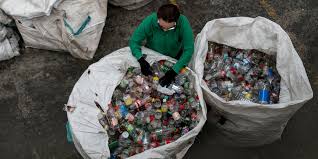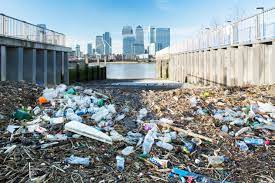Recycling is the collection, processing, and reuse of materials that would otherwise be thrown away. Materials ranging from precious metals to broken glass, from old newspapers to plastic spoons, can be recycled. The recycling process reclaims the original material and uses it in producing new products.
Internal and External Recycling
Recycling can be done internally (within a company) or externally (after a product is sold and used).
Internal Recycling
Internal recycling occurs in the paper industry, for example, when leftover stock and trimmings are salvaged to help make more new product. Since the recovered material never left the manufacturing plant, the final product is said to contain preconsumer waste.
External Recycling
External recycling occurs when materials used by the customer are returned for processing into new products. Materials ready to be recycled in this manner, such as empty beverage containers, are called postconsumer waste.
Types of Materials Recycled
Just about any material can be recycled. On an industrial scale, the most commonly recycled materials are those that are used in large quantities – metals such as steel and aluminum, plastics, paper, glass, and certain chemicals.
1. Steel
There are two methods of making steel using recycled material: the basic oxygen furnace (BOF) method and the electric arc furnace (EAF) method. The BOF method involves mixing molten scrap steel in a furnace with new steel. About 28 percent of the new product is recycled steel.
Steel made by the BOF method typically is used to make sheet- steel products like cans, automobiles, and appliances. The EAF method normally uses 100 percent recycled steel. Scrap steel is placed in a furnace and melted by electricity that arcs between two carbon electrodes.
Limestone and other materials are added to the molten steel to remove impurities. Steel produced by the EAF method usually is formed into beams, reinforcing bars, and thick plate. Approximately 64 percent of all steel is recycled; making it one of the world’s most recycled materials.
2. Aluminum
The overall recycling rate of all forms of aluminum is about 35 percent. Cans brought to collection centers are crushed, baled, and shipped to regional mills or reclamation plants.
The cans are then shredded to reduce volume and heated to remove coatings and moisture. Next, they are put into a furnace, melted, and formed into ingots, or bars, weighing 10,000 kg (30,000 lb) or more.
The ingots go to another mill to be rolled into sheets. The sheets are sent to a container plant and cut into disks from which new cans are formed. The cans are printed with the beverage makers’ logos and are shipped (with tops separate) to the filling plant.
3. Plastics
Plastics are more difficult to recycle than metal, paper, or glass. One of the problems is that any of the seven categories of plastics can be used for containers alone. For effective recycling, the different types cannot be mixed.
Most states require that plastic containers have identification codes so that they can be more easily identified and separated.
The code assigns a particular number to each of the seven plastics used in packaging. Number 1 refers to polyethylene teraphthalate (PET) and number 2 refers to high-density polyethylene (HDPE).
PET can be made into carpet, or fiberfill for ski jackets and clothing. HDPE can be recycled into construction fencing, landfill liners, and a variety of other products. Plastics coded with the number 6 are polystyrene (PS), which can be recycled into cafeteria trays, combs, and other items.
The recycling process for plastic normally involves cleaning it, shredding it into flakes, then melting the flakes into pellets. The pellets are then melted into a final product. Some products work best with only a small percentage of recycled content.
Other products, such as HDPE plastic milk cases, can be made successfully with 100 percent recycled content. The plastic container industry has concentrated on weight reduction and source reduction.
For example, the one-gallon HDPE milk container that weighed about 120 gm (about 4.2 oz) in the 1960s weighed just 65 gm (about 2.3 oz) in 1996.
4. Paper and Paper Products
Paper products that can be recycled include cardboard containers, wrapping paper, and office paper. The most commonly recycled paper product is newsprint.
In newspaper recycling, old newspapers are collected and searched for contaminants such as plastic bags and aluminum foil. The paper goes to a processing plant where it is mixed with hot water and turned into pulp in a machine that works much like a big kitchen blender.

The pulp is screened and filtered to remove smaller contaminants. The pulp then goes to a large vat where the ink separates from the paper fibers and floats to the surface. The ink is skimmed off, dried and reused as ink or burned as boiler fuel. The cleaned pulp is mixed with new wood fibers to be made into paper again.
5. Glass
Scrap glass taken from the glass manufacturing process, called cullet, has been internally recycled for years. The scrap glass is economical to use as a raw material because it melts at lower temperatures than other raw materials, thus saving fuel and operating costs.
Glass that is to be recycled must be relatively free from impurities and sorted by color. Glass containers are the most commonly recycled form of glass, and their colors are flint (clear), amber (brown), and green.
Other glass, such as window glass, pottery, and cooking utensils, are considered contaminants because they have different compositions from glass used in containers. The recycled glass is melted in a furnace and formed into new products.
Chemicals and Hazardous Waste
Household hazardous wastes include drain cleaners, oven cleaners, window cleaners, disinfectants, motor oil, paints, paint thinners, and pesticides. Most municipalities ban hazardous waste from the regular trash.
Periodically, citizens are alerted that they can take their hazardous waste to a collection point where trained workers sort it, recycle what they can, and package the remainder in special leak-proof containers called lab packs, for safe disposal.
Typical materials recycled from the collection drives are motor oil, paint, antifreeze, and tires. Business and industry have made much progress in reducing both the hazardous waste they generate and its toxicity.
Although large quantities of chemical solvents are used in cleaning processes, technology has been developed to clean and reuse solvents that used to be discarded.
Even the vapors evaporated from the process are recovered and put back into the recycled solvent. Some processes that formerly used solvents no longer require them.
Nuclear Waste
Certain types of nuclear waste can be recycled, while other types are considered too dangerous to recycle. Low-level wastes include radioactive material from research activities, medical wastes, and contaminated machinery from nuclear reactors.
Nickel is the major metal of construction in the nuclear power field and much of it is recycled after surface contamination has been removed.
High-level wastes come from the reprocessing of spent fuel (partially depleted reactor fuel) and from the processing of nuclear weapons. These wastes emit gamma radiation, which can cause birth defects, disease, and death.
High-level nuclear waste is so toxic it is not normally recycled. Instead, it is fused into inert glass tubes encased in stainless steel cylinders, which are then stored underground.
Reasons for Recycling
Rare materials, such as gold and silver, are recycled because acquiring new supplies is expensive. Other materials may not be as expensive to replace, but they are recycled to conserve energy, reduce pollution, conserve land, and to save money.
1. Resource Conservation
Recycling conserves natural resources by reducing the need for new material. Some natural resources are renewable, meaning they can be replaced, and some are not Paper, corrugated board, and other paper products come from renewable timber sources.
Trees harvested to make those products can be replaced by growing more trees. Iron and aluminum come from nonrenewable ore deposits. Once a deposit is mined, it cannot be replaced.
2. Energy Conservation
Recycling saves energy by reducing the need to process new material, which usually requires more energy than the recycling process.
To make aluminum can from recycled metal takes only 5 percent of the total energy needed to produce the same aluminum can from un-recycled materials, a 95 percent energy savings.
Recycled paper and paperboard require 75 percent less energy to produce than new products. Significant energy savings result in the recycling of steel and glass, as well.
3. Pollution Reduction
Recycling reduces pollution because recycling a product creates less pollution than producing a new one. For every ton of newspaper recycled, 7 fewer kg (16 lb) of air pollutants are pumped into the atmosphere.
Recycling can also reduce pollution by recycling safer products to replace those that pollute. Some countries still use chlorofluorocarbons (CFCs) to manufacture foam products such as cups and plates.
Many scientists suspect that CFCs harm the atmosphere’s protective layer of ozone. Using recycled plastic instead for those products eliminates the creation of harmful CFCs.
4. Land Conservation
Recycling saves valuable landfill space, land that must be set aside for dumping trash, construction debris, and yard waste. Landfills fill up quickly and acceptable sites for new ones are difficult to find because of objections by neighbors to noise and smells, and the hazard of leaks into underground water supplies.
The two major ways to reduce the need for new landfills are to generate less initial waste and to recycle products that would normally be considered waste. Solid waste can also be burned instead of buried in the ground.
5. Economic Savings
Recycling in the short term is not always economically profitable or a break-even financial operation. Most experts contend, however, that the economic consequences of recycling are positive in the long term.
Recycling will save money if potential landfill sites are used for more productive purposes and by reducing the number of pollution-related illnesses.
In summary, in general, using recycled materials to make new products costs less and requires less energy than using new materials and recycling can also reduce pollution, either by reducing the demand for high-pollution alternatives or by minimizing the amount of pollution produced during the manufacturing process.
Recycling decreases the amount of land needed for trash dumps by reducing the volume of discarded waste.
Recycling is the collection, processing, and reuse of materials that would otherwise be thrown away. The most commonly recycled materials are those that are used in large quantities.
Read Also : Classification of Pollutants and their Impact on the Environment
Recycling conserves natural resources by reducing the need for new material. Recycling saves energy by reducing the need to process new material, which usually requires more energy than the recycling process.
Recycling reduces pollution because recycling a product creates less pollution than producing a new one.
Recycling saves valuable landfill space, land that must be set aside for dumping trash, construction debris, and yard waste.

